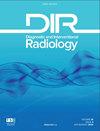Diagnostic value of qualitative and quantitative enhancement parameters on contrast-enhanced mammography.
IF 1.7
4区 医学
Q2 Medicine
引用次数: 0
Abstract
PURPOSE To determine whether qualitative and quantitative enhancement parameters obtained from contrast-enhanced mammography (CEM) can be used in predicting malignancy. METHODS After review board approval, consecutive 136 suspicious lesions with definite diagnosis were retrospectively analyzed on CEM. Acquisition was routinely started with craniocaudal view and ended with mediolateral oblique view of the affected breast. Lesion conspicuity (low, moderate, high), internal enhancement pattern (homogeneous, heterogeneous, rim), contrast-to-noise ratio (CNR), percentage of signal difference (PSD) and relative enhancement from early to late view were analyzed. PSD and relative enhancements were used to determine patterns of descending, steady or ascending enhancements. Receiver operating characteristic analysis, Cohen's kappa statistics and Spearman correlation tests were used. RESULTS There were 29 benign and 107 malignant lesions. 64% of the malignant lesions exhibited high conspicuity compared to 14% of the benign lesions (P < 0.001). CNR values were higher in malignant lesions compared to benign ones (P ≤ 0.004). CNR from early view yielded 82% sensitivity, 72% specificity and PSD yielded 79% sensitivity, 65% specificity. Descending pattern and rim enhancement observed in 44% and 21% of breast cancers, respectively, and both provided 96% positive predictive value for malignancy. CONCLUSION Diagnostic accuracy of quantitative parameters was higher than that of qualitative parameters. High CNR, rim enhancement, and descending pattern were features commonly seen in malignant lesions, while low CNR, homogeneous enhancement, and ascending pattern were commonly seen in benign lesions.对比增强乳腺 X 射线摄影中定性和定量增强参数的诊断价值。
目的确定造影剂增强乳腺 X 线摄影(CEM)获得的定性和定量增强参数是否可用于预测恶性肿瘤。方法经审查委员会批准后,对连续 136 例有明确诊断的可疑病变进行 CEM 回顾性分析。采集时常规从患侧乳房的头颅后方切面开始,以内侧斜切面结束。分析了病变的清晰度(低、中、高)、内部增强模式(均质、异质、边缘)、对比度与噪声比(CNR)、信号差百分比(PSD)以及从早期视图到晚期视图的相对增强情况。PSD 和相对增强用于确定下降型、稳定型或上升型增强模式。结果29个良性病变和107个恶性病变。64%的恶性病变表现出高度的明显性,而良性病变仅为 14%(P < 0.001)。恶性病变的 CNR 值高于良性病变(P ≤ 0.004)。早期视图的 CNR 敏感性为 82%,特异性为 72%,而 PSD 的敏感性为 79%,特异性为 65%。在44%和21%的乳腺癌中分别观察到了下降模式和边缘增强,两者对恶性肿瘤的阳性预测值均为96%。高CNR、边缘强化和下降模式是恶性病变的常见特征,而低CNR、均匀强化和上升模式则常见于良性病变。
本文章由计算机程序翻译,如有差异,请以英文原文为准。
求助全文
约1分钟内获得全文
求助全文
来源期刊
CiteScore
3.50
自引率
4.80%
发文量
69
审稿时长
6-12 weeks
期刊介绍:
Diagnostic and Interventional Radiology (Diagn Interv Radiol) is the open access, online-only official publication of Turkish Society of Radiology. It is published bimonthly and the journal’s publication language is English.
The journal is a medium for original articles, reviews, pictorial essays, technical notes related to all fields of diagnostic and interventional radiology.

 求助内容:
求助内容: 应助结果提醒方式:
应助结果提醒方式:


